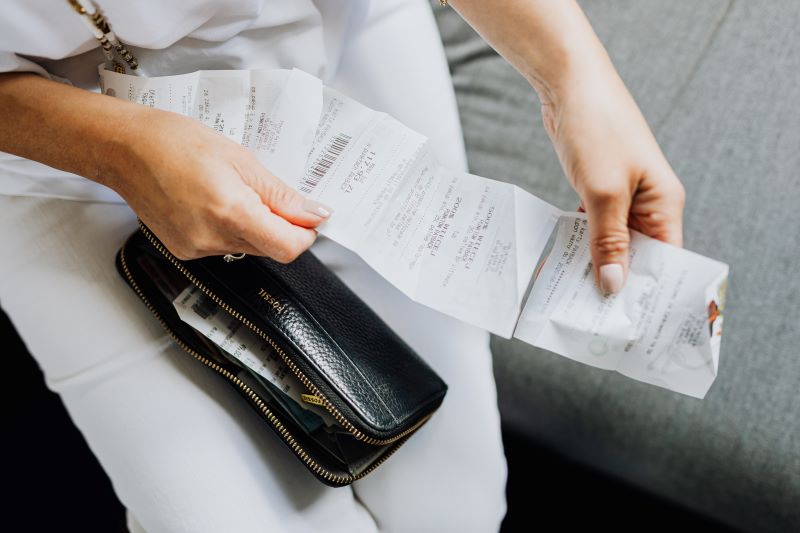RESEARCH EXCELLENCE INITIATIVE
FREEDOM OF RESEARCH – SCIENCE FOR THE FUTURE
“Freedom of Research – Science for the Future” series consists of articles, interviews and short videos presenting research conducted by the winners of the “Freedom of Research” call for proposals
Joanna Orzeł, PhD
Bisphenols – sneaky poisoners
| Weronika Cygan |
Plastics surround us everywhere. We find microplastic particles in places that seemed to be untouched by man. We can detect them in Antarctic snow and in the ocean depths. We even find their traces in human blood. The commonness of these toxic compounds makes it so important to look for ways to detect them effectively.
Toxic receipts
“Bisphenols are substances that disrupt the work of many systems of our body, especially the endocrine system. They can even lead to infertility.” says Joanna Orzeł, PhD, from the Faculty of Science and Technology of the University of Silesia. As part of the “Freedom of research” competition of the Research Excellence Initiative, the chemist developed a method that enables the qualitative and quantitative assessment of the occurrence of substances from the group of bisphenols BPA, BPS and BPF, which are harmful to humans and the environment. We can find them, among others, in plastic bottles or on receipts that we receive during shopping.
The fact that this small piece of paper carries a huge risk to human health is confirmed by studies during which the content of bisphenols in the urine and blood of cashiers who have daily contact with a huge number of receipts was checked. “Concentrations of toxic substances in their blood were increased by a dozen, or even several hundred times when they touched the bills directly with their hands. In turn, those who wore gloves during work, the concentrations did not differ from those recorded in people who did not have as much contact with a similar number of bills as cashiers.” notes Joanna Orzeł, PhD.
Bisphenols are generated into the environment as the result of various processes. In the case of receipts, their source is a thermoactive printing tape. Because of the heat that reaches the tape, chemical reaction takes place on its surface, and as a result, the substances are released. Toxic compounds also escape as a result of damaging the object. This is what happens with plastic containers for storing drinks or food. Their intensive use causes abrasion of the layer in various places, and the structure disturbed in this way makes bisphenols much easier to wash out, and as a consequence, bisphenols can penetrate into the human body or the environment.
The fact that toxic substances are so widespread in the world around us, and therefore interact with the human and animal bodies in various ways, disrupting the functioning of many important systems, prompts scientists to look for more and more effective methods to detect them.

Joanna Orzeł, PhD | Private Archive
Towards “green chemistry”
Standard methods for the detection and labelling of bisphenols are based on chromatography, thanks to which high precision and accuracy of measurements are achieved. In the long run, however, this is an extremely time-consuming and costly method, often generating harmful chemical waste. The procedure used by Joanna Orzeł, PhD, is a more ecological and economical solution.
The method is based on spectrofluorimetric measurements of water-ethanol extracts of samples containing bisphenols. In the entire process, cyclodextrins play an important role, as their task is to amplify the signal emitted by the individual components of the test substance. It is especially important to maintain stable chemical conditions. As the chemist notes, the method developed by her also requires great analysis skills.
“The solution I propose may not be new, because the use of fluorescence spectrometry for the determination of bisphenols is described in the literature, but the use of cyclodextrins in my experiment allows for the determination of these substances in a more accurate and cheaper way than the solutions recommended so far in scientific studies. The procedure is also definitely faster.” explains Joanna Orzeł, PhD. The chemical reagents used in the method are also characterised by lower toxicity, both for the environment and the person who uses them.
In recent years, more and more scientists are involved in the search for solutions that fit into the so-called green chemistry. These are methods that do not leave such a strong footprint on the environment as those used in previous decades. According to the researcher from the Faculty of Science and Technology, it is the direction set by the ecological approach that will be more and more desirable in science, and the method of using fluorescence spectrometry (developed by her) fits perfectly into this trend, e.g. by limiting the amount of toxic waste in nature or lowering the energy costs of analyses.
For the time being, there is still a long way to commercial use of the bisphenol detection method developed by Joanna Orzeł, PhD, but it has the potential to be used, for example, in waste treatment plants. However, the method would require appropriate adaptation. “We must be aware that such places have such a rich chemical composition that the cyclodextrins and bisphenols used in the process can be lost in this chemical soup” says the researcher from the University of Silesia.

Photo: Karolina Grabowska | Pexels
Do the labels tell the truth?
Why is it so important to develop new solutions for precise detection of toxic compounds? The society is often not aware of how many of them there are present in our environment, and that more and more are still added to the catalogue of already known ones. Joanna Orzeł, PhD draws attention to the risk of misleading the consumer or the lack of complete information on specific products.
“Especially people who have small children are bombarded with “BPA free” labels. It is said that this substance is harmful and we should avoid it, but bisphenols include a whole range of dangerous compounds, such as BPF or BPS. There are plenty of them. In my research, I focused on the three most popular ones, because although the use of bisphenol A is prohibited, its analogues and other substances from this group are applied. Their use is not prohibited, but in fact, they are often even more toxic” notes the chemist.
In recent years, a lot has been said about the threat posed by environmental pollution with plastic and the difficulties with its disposal. That is why it is so important for manufacturers to invest in creating materials that are as environmentally friendly as possible. It is known that decomposing bottles, CDs, disposable masks and many other plastic-containing garbage accumulate in the environment. Harmful compounds find their way into the soil or surface waters, and as a consequence, plants, animals and people are exposed to them.
“In my research, I was able to determine that even after twenty years, the thermal paper on which receipts are printed still contains bisphenol. Their concentration was also high in the liquid stored in polycarbonate containers with very heavy traces of use and scratched walls. As a result of the damaged structure of the polymer, the contact surface increases, and therefore more toxic substances penetrate into the drink or food stored in such a container” explains Joanna Orzeł, PhD.
In the modern world, it is impossible to completely eliminate bisphenols from the environment, but it is certainly worth trying to reduce their presence, e.g. by replacing plastic containers with glass. It is also worth to remember about the proper disposal of harmful waste, as it minimises its impact on your own health and the natural environment.





